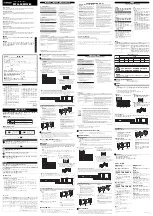
App. - 7 App. - 7
MELSEC-Q
APPENDIXES
Appendix 1.2 Precautions When Updating the Module from Function Version A to B
This section explains how to utilize programs created for the Q series C24 of function
version A for the Q series C24 of function version B and how to incorporate function
version B into the existing system.
(1) Program utilization
Programs created for the Q series C24 of function version A can be used as they
are for the Q series C24 of function version B.
(2) Incorporation into the existing system
The wiring used for function version A can be used as is for the Q series C24 of
function version B.
Appendix 1.3 Precautions When Replacing the QJ71C24(-R2) with the QJ71C24N(-R2/R4)
Although the QJ71C24N(-R2/R4) can use existing programs created for the
QJ71C24(-R2) without any changes, take into account the following.
Wiring for the QJ71C24(-R2) can be also used as it is.
(1) Increased internal processing speed
Since the internal processing speed has been increased, the time taken for the
QJ71C24N(-R2/R4) to access a programmable controller CPU and to process
message transmission to another device is shorter than that of the QJ71C24(-
R2). (The usage of functions has not been changed, however, the performance
and response time is different.)
When utilizing any existing program, be sure to check the operation in advance
and, if necessary, adjust the communication timing.
The following are examples of communication timing adjustment.
(a) When communicating with MC protocol
Increase the message wait time.
Especially, in the case of "Sequence scan time > Message wait time", an
adjustment is required.
If the message wait time is too short, the external device may not be able to
receive all or the first part of a response message from the Q series C24.
1) For the QnA compatible 3C/4C frames, specify a message wait time in
the buffer memory (address 11E
H
/1BE
H
).
2) For the A compatible 1C frames, specify a message wait time in a
request message sent from the external device.
(b) When communicating with the non-procedure or bidirectional
protocol
Delay the data transmission timing.
1) Data transmission from the external device to the QJ71C24N(-R2/R4)
Delay the timing of transmission from the external device. (Adjusted on
the external device side)
2) Data transmission from QJ71C24N(-R2/R4) to the external device
For communications with the non-procedure protocol, delay the data
transmission by one scan in the sequence program. (For
communications with the bidirectional protocol, delay the timing of
turning ON the reception data read completion signal by one scan as
well.)
Summary of Contents for MELSEC QJ71C24
Page 1: ......
Page 2: ......
Page 103: ...3 42 3 42 MELSEC Q 3 SPECIFICATIONS MEMO ...
Page 177: ...6 33 6 33 MELSEC Q 6 DATA COMMUNICATION USING THE NON PROCEDURE PROTOCOL MEMO ...
Page 397: ...App 24 App 24 MELSEC Q APPENDIXES Connection example 3 Connection example 4 ...
Page 441: ......
Page 442: ......
















































